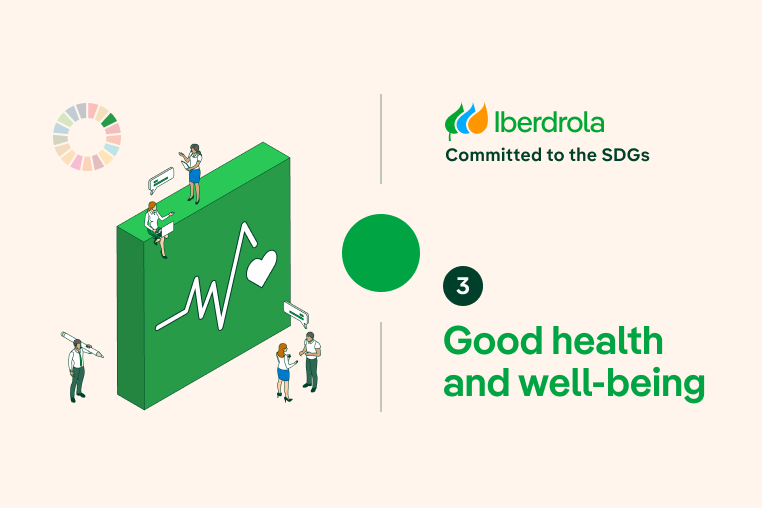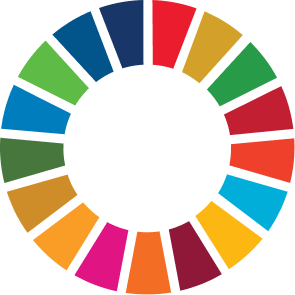SDG 3: Good health and well-being
Our employees’ health is at the forefront of our priorities
Iberdrola seeks the safety and health of its employees, with the goal of reaching zero accidents and making workplaces increasingly healthier. To this end, we have a Strategic Plan for Occupational Health and Safety.
Goal 3: Good health and well-being. Video voice transcription (Spanish version) [PDF] External link, opens in new window.
Our contribution to SDG 3: Health and well-being
One of the objectives of Iberdrola's Strategic Health and Safety Plan is to reduce accident rates in the business globally to achieve zero accidents and to make the workplace a healthier place, while promoting a culture of excellence.
Iberdrola also cares about the most disadvantaged, and we therefore encourage our employees to participate in campaigns to collect staple foods among our employees. In 2023, more than 810,000 menus were prepared and distributed to vulnerable families through volunteer activities.
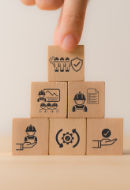
Occupational health & safety
A safe and healthy workplace throughout the whole Group.
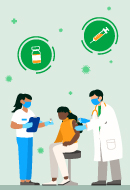
The history of vaccines
The history of vaccines, crucial for combating disease.

Mental hygiene
Things you need to do to look after your mind and keep a good quality of life.
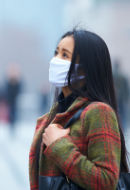
Air quality
Is the quality of the air you breathe healthy?
What is Sustainable Development Goal 3: Health and well-being?
The goals within SDG 3 seek to guarantee a healthy life and promote well-being for all ages, thus safeguarding sustainable development. Its objectives include reducing the global maternal mortality rate and ending avoidable deaths of newborns and children under the age of five years. It seeks to end epidemics and infectious and non-infection diseases through prevention and treatment.
Why is it so important to achieve SDG 3: Health and well-being?
Ensuring a healthy life and promoting the well-being of all the world's people is essential if prosperous societies are to exist. Access to health and well-being is a human right, however, inequality when it comes to access to healthcare persists, and every year, millions of people die because they do not receive adequate care.
The COVID-19 pandemic has challenged the great advances achieved in improving the health of millions of people around the world.
According to the UN Child Mortality Report, 5 million children died under the age of five. This means that 38 per 1,000 births end in death, with the most dangerous place to be born being sub-Saharan Africa, with 74 deaths per 1,000 births. The biggest problem currently exists between this area and South Asia, with more than 80% of the world's deaths.
When it comes to the world neonatal mortality rate, this has been reduced from 31 deaths per 1,000 live births in 2000 to 18 deaths in 2021. Sub-Saharan Africa is the region with the highest rate: one in 13 children died before reaching the age of five.
Reducing the number of premature deaths requires progress in access to clean water and sanitation (SDG6), which will help to reduce lethal and infectious diseases, such as malaria and tuberculosis, and slow the spread of HIV. Quality, affordable health care, improved nutrition and increased availability of vaccines will also be critical to curbing child and maternal mortality.
Faced with this situation, reducing the child and maternal mortality rates and ending epidemics became the SDG 3 of the 17 UN Sustainable Development Goals, approved in September 2015 during the Sustainable Development Summit, a meeting at which more than 150 heads of State and Government approved the 2030 Agenda.
Iberdrola aligned with the sdg
Keys to understanding child mortality worldwide
Who is affected?
5.3 million children under the age of five
died in 2018.
45.5 % died during their first month of life
as a result of premature birth, low weight, infections, asphyxiation or birth trauma.
How is it distributed across the world?
52.5 % is concentrated in Africa, 42.7 % in Asia, 3.3% in Latin America and the Caribbean, 1.3 % in North America and Europe and 0.2 % in Oceania.
The 10 countries with the highest child mortality
are all in Africa, where for every 1,000 children under five born alive the following numbers die (— in thousands —):
150
120
90
60
30
0
Main causes
Lack of access to clean water and sanitation, malnutrition, low availability of vaccines and lack of good quality health care, leading to problems in childbirth and the spread of diseases such as malaria, tuberculosis and HIV.
HOW CAN WE END IT?
We must invest more resources to improve primary health systems — such as vaccines and antibiotics —, increase breastfeeding and the supply of clean water and nutrition. In addition, universal basic education must be promoted.
Source: 2019 Report (Unicef, World Health Organization, European Bank, United Nations) and UN (2017).
 SEE INFOGRAPHIC: Keys for understanding child mortality worldwide [PDF] External link, opens in new window.
SEE INFOGRAPHIC: Keys for understanding child mortality worldwide [PDF] External link, opens in new window.
SDG 3 targets: Health and well-being
The specific targets set for 2030 are:
-
Reduce the global maternal mortality rate to less than 70 deaths per 100,000 live births.
-
Ensure that all countries decrease neonatal mortality to at least as low as 12 per 1,000 live births and mortality in under fives to at least as low as 25 deaths per 1,000 live births.
-
Guarantee universal access to sexual and reproductive health services, including family planning, information and education.
-
Reduce the number of deaths and illnesses caused by hazardous chemicals and water, soil and air pollution.





